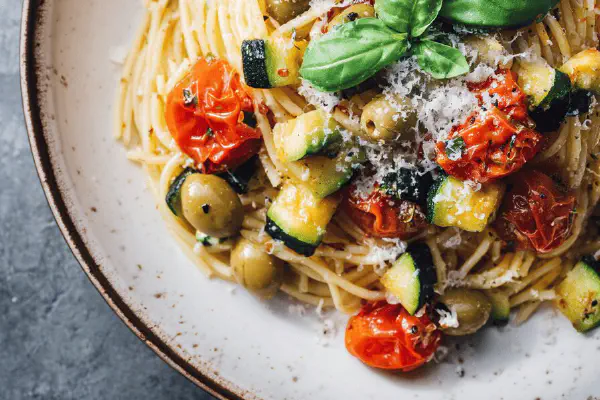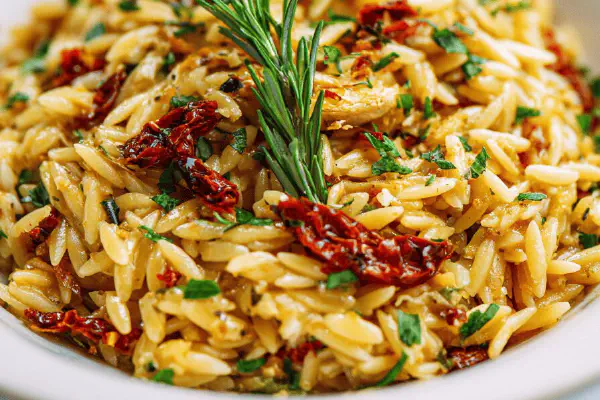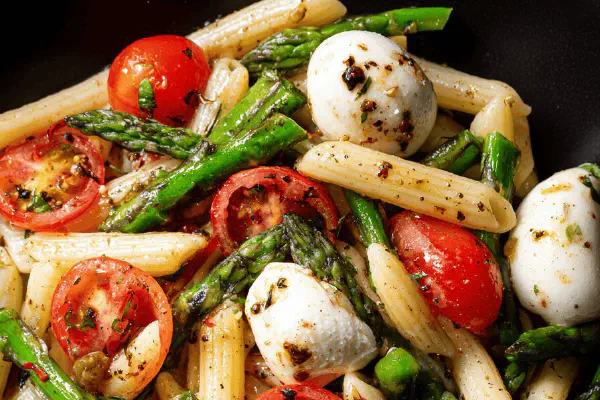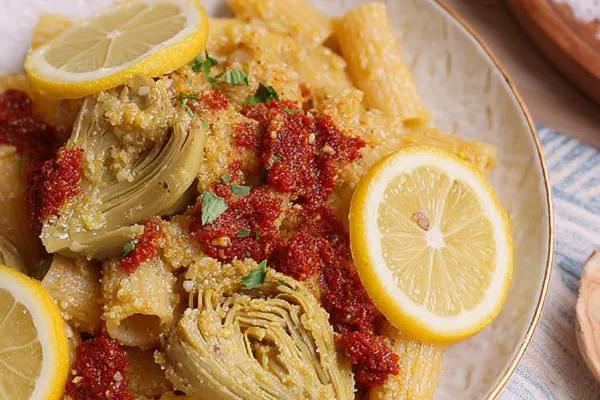Featured Recipe
Pasta Salad with Pepperonata Twist
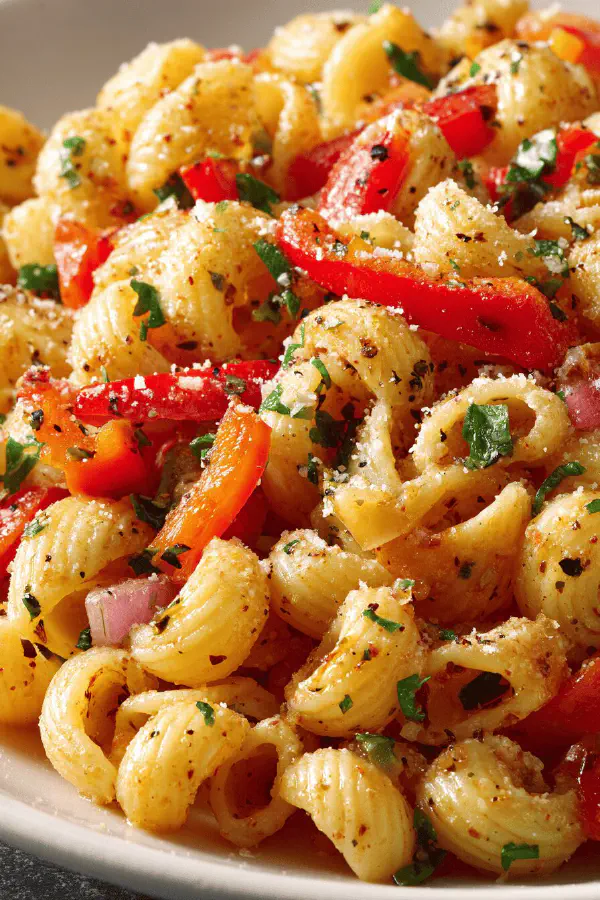
By Kate
"
A pasta salad featuring short pasta tossed with a pepperonata mix of sautéed bell peppers and shallots, finished with a tangy vinaigrette and aged Asiago cheese. The dish is vegetarian, dairy-free except for cheese garnish, and nut-free. Substitutions offered for Asiago and honey to accommodate dietary preferences. Emphasis on cooking peppers to softness with caramelized edges and cooling pasta promptly to maintain texture. Balanced acidity from vinegar cuts through the silkiness of the oil and cheese, while fresh herbs brighten the finish.
"
Prep:
20 min
Cook:
30 min
Total:
50 min
Serves:
8 servings
pasta
salad
vegetarian
Mediterranean
quick meal
Introduction
Skipping complex steps sometimes turns a solid dish into confusion. Here, short pasta acts as a canvas — quick boiling, immediate chilling essential to preserve texture. Peppers and shallots cook slowly until soft and caramelized, not just tossed in raw. The vinegar and agave balance sweetness and tang. Asiago, not parmesan, changes flavor profile with nuttier tones. Fresh basil added late keeps it bright. Tossing warm pasta with pepperonata allows flavors to meld but keep integrity. Simple ingredients, focused technique, sensible timing create layers of taste without fuss. Pay close attention to how peppers look and feel during sauté — that’s the real indicator, not the clock. No rushing here.
Ingredients
Vinaigrette
- 40 ml (2 ½ tbsp) extra virgin olive oil
- 25 ml (1 ½ tbsp) white wine vinegar
- 4 scallions, thinly sliced
- 150 ml (⅔ cup) shaved aged Asiago cheese
- Fresh chopped basil
- Salt and freshly ground black pepper
About the ingredients
Bell peppers should be chosen ripe for sweet flavor. Color variety adds visual appeal and taste complexity. Shallots replace onions for gentler fragrance and subtle sharpness. Capers contribute a savory brine punch but can be swapped with green olives if needed; omit only if allergic. Agave syrup replaces honey for vegan option, but maple syrup or mild corn syrup work too. Oil quality can make or break, so use a good fruit-forward olive oil. Asiago cheese adds a nuttier, creamier layer; parmesan can substitute but use sparingly to avoid overpowering. Fresh basil tops it off with herbal freshness but can switch to parsley or oregano based on preference. Pasta must be short shapes prone to holding onto chunks and sauce. Fusilli or penne recommended, rigatoni too. Key is even cooking and quick chill post boil to avoid mush.
Method
Pepperonata Preparation
- Bring a large pot of salted water to a boil. Use a handful of salt so pasta absorbs seasoning. Add pasta and cook until just shy of al dente — about 8 minutes but start checking early. Drain and rinse under cold water immediately to stop cooking and cool quickly. Toss lightly with a drizzle of olive oil to prevent sticking. Set aside.
- Heat a heavy skillet over medium heat. Add the olive oil and swirl. Toss in diced peppers. Listen for a gentle sizzle that indicates proper heat. Sauté until peppers soften and start showing golden-brown spots — edges should caramelize slightly but not burn. Add shallots; after 2 minutes, they should become translucent but not mushy. Stir frequently to avoid scorching.
- Add chopped capers, white wine vinegar, and agave syrup. Reduce heat to low and simmer uncovered, stirring occasionally until liquid nearly evaporates and mixture thickens, about 20 minutes. Look for a glossy sheen on the mixture and note the intensified aroma. Remove from heat and cool to room temperature.
- In a large bowl, combine lukewarm pasta with pepperonata mix. The pasta should still have some warmth to better absorb flavors but not so hot it wilts scallions or cheese.
- Whisk together olive oil, vinegar, sliced scallions, salt, and pepper for dressing. Pour over pasta and toss gently but thoroughly to combine. Avoid over mixing to keep pasta integrity intact.
- Taste and adjust salt and acidity if needed. Add freshly chopped basil for a herbaceous pop. Finish by garnishing with Asiago shards.
- Serve at room temperature. Should not be cold from fridge or piping hot. Texture: tender pasta with tender-crisp peppers, sharp bursts from capers, smooth vinegary oil, and creamy cheese shards.
- Leftovers benefit from sitting an hour to mingle flavors but do not refrigerate more than a day to avoid mushy textures.
Assembly and Dressing
Technique Tips
Pasta cooking is straightforward but timing is art. Test several pieces early to find that slight snap of al dente rather than mushy softness. Immediate cold rinse stops residual heat cooking; don’t skip this or you’ll lose pasta bite. When sautéing peppers, medium heat is crucial — too hot burns edges, too low leaves raw crunch. Texture changes and aroma shift signal readiness. Shiny, slightly softened with caramel spots means good. Adding vinegar and reducing down concentrates flavor with slight stickiness on pan bottom; watch closely to avoid burning or drying too much. Mixing pasta warm helps soak flavors, but over-warm or hot kills freshness of scallions and melts cheese prematurely. Toss gently to avoid breaking pasta. Basil added last prevents browning or bitterness. Serving at true room temperature keeps aroma lively and texture firm. If making ahead, hold chilled but bring out 15 minutes before serving. Leftovers lose charm after 24 hours as oil emulsions separate and pasta absorbs too much moisture.
Chef's Notes
- 💡 Cook pasta firm. Al dente is your goal. Test early. Undercooked works better. Cold rinse fast. Stopping heat prevents mush. Add oil to avoid clumping.
- 💡 Sauté peppers on medium heat. Watch closely. Golden-brown edges signal doneness. Don’t rush. Shallots should soften but not lose shape. Stir well to avoid burning.
- 💡 Balance vinegar and sweet. Too much vinegar ruins flavor. Add in stages while reducing. Pay attention to viscosity. Should thicken; glossy look means right.
- 💡 Mix warm not hot pasta with room temperature pepperonata. Helps absorb flavors without melting cheese. Avoid cold pasta with hot mixture. Wrap it gently.
- 💡 Fresh herbs are critical. Basil added late prevents browning. You can switch to parsley. Skip bruising by adding just before serving. Keep vibrant flavors.
Kitchen Wisdom
What’s the best pasta for salad?
Short shapes are key. Fusilli, penne hold onto ingredients well. Don’t pick long pasta. They don’t cling enough.
How to avoid soggy peppers?
Slow sauté is crucial. Medium heat golden spots. Not raw. Colorful bell peppers ensure sweetness. Under-cook slightly for crunch.
Can I substitute capers?
Yes, green olives work but do adjust flavor; brine level differs. If allergic, skip. Layer with more vinegar or herbs.
How should I store leftovers?
Store in breathable container. Keeps moisture away. Don’t wrap tightly. Eat within a day. Dry out texture if kept too long.
